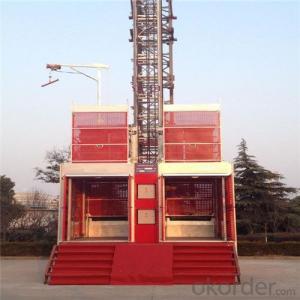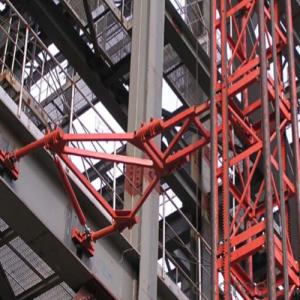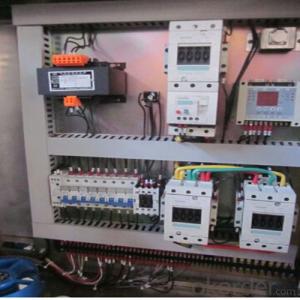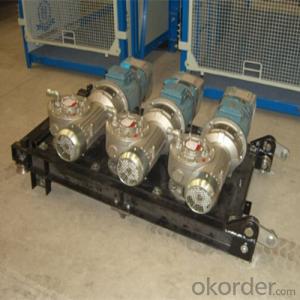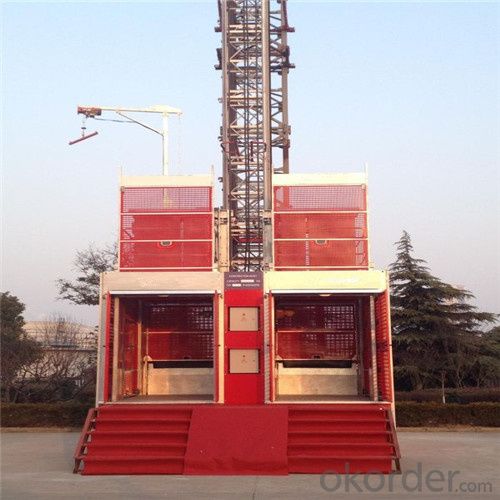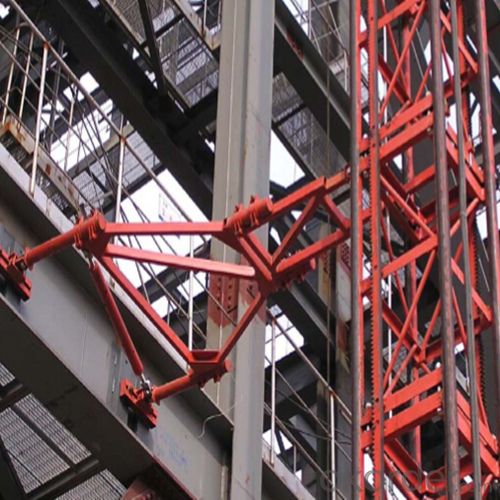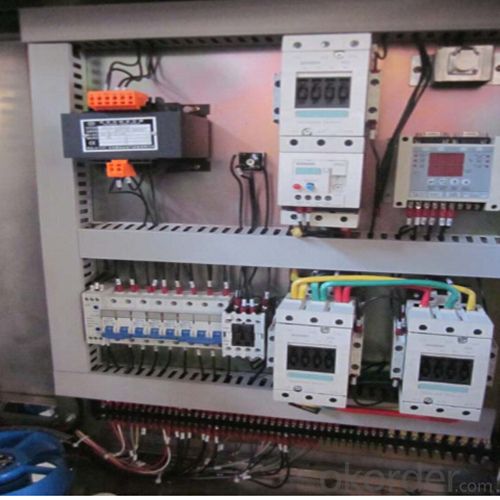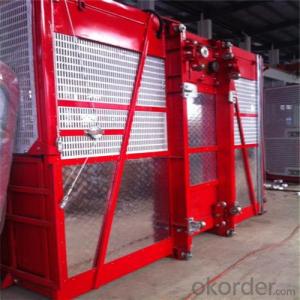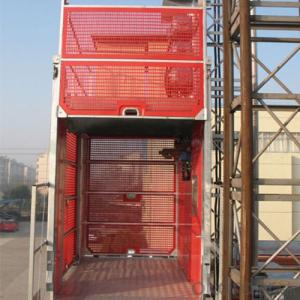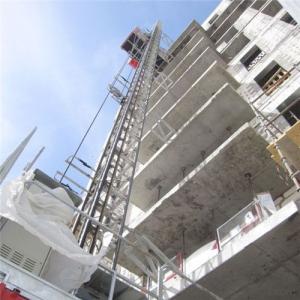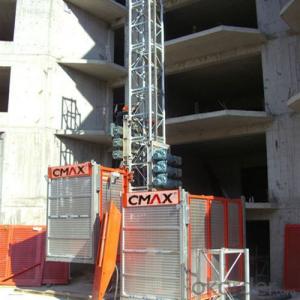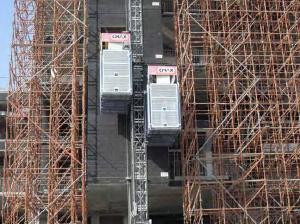Building Hoist SC160/160 Twin Cage 0~60m/min
- Loading Port:
- China main port
- Payment Terms:
- TT or LC
- Min Order Qty:
- 1 unit
- Supply Capability:
- 30 unit/month
OKorder Service Pledge
OKorder Financial Service
You Might Also Like
Structure of Building Hoist Description
Feature: Building Hoist Condition: New Application: Construction
Payload(kg):2*1600 Lifting Speed(m/min):0~60 Motor Power(kw): 2*3*15
Safety Device: 2*SAJ30-1.4 Cage: Twin Counterweight: No
Certification: CE,ISO Place of Origin: China(Mainland) Model Number: Type:SC160/SC160
Packaging & Delivery of Building Hoist
Packaging Detail: Nude package Delivery Detail: 25-30days
Main Parts of Building Hoist
● Adopts the most advanced VF speed control device and microcomputer programmable logic controller.
● Stepless speed control helps eliminate the concussion during start up and braking, steady the operation process,
and ensures automated leveling.
● Adopts open loop V/Fcontrol; the speed control precision can reach ±2~3%. Realizes accurate low speed positioning of the hoist and avoid slipping during downward stopping of hoist.
● The VF system has current-restriction function, ensuring a small current when motor start up and reducing the concussion to power supply. It reduces the engery consumption and mitigates effects to on site electric equipments.
● The steadiness during running mitigates concussion to mechanical parts, reduces wears of rack, pinion and the brake
and prolongs the spare parts'life.
● The VF system also has the over voltage protection,low voltage protection, overcurrent, overload and anti-stalling protection functions,
● The system applies the special software for hoists developed by our company, making the operation more safe and
reliable.
Building Hoist Images
CMAX Building Hoist
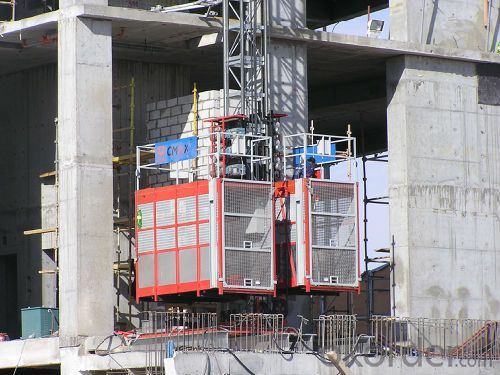
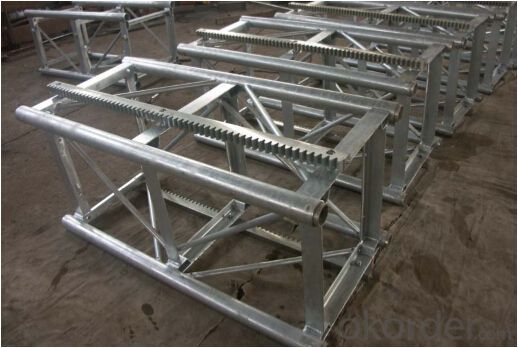
Building Hoist Specifiction
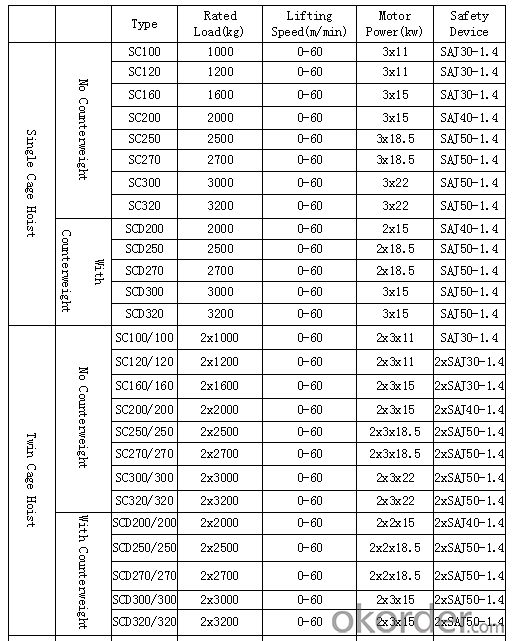
FAQ of Building Hoist
Q: What is the building hoist main purpose?
A: Building hoist equipped with double or single cabin to transport the materials and labors up and down. It's the ideal
construction equipment for vertical transportation in the field of construction.
Q: What is the main structure of building hoist?
A: The P/M construction hoist mainly contains metal structure, driving system, electrical control system, cable guide &
protection system, electrical top crane and safety device.
Q: What is the meaning of the building hoist’s code?
A: Take SC200/200 for example: “SC” stands for rack and pinion hoist, “200/200” stands for double cage and capacity
is 2 tons per cage. “SC200” stands for single cage and capacity is 2 tons.
Q: What is the dimension of the cage?
A: Normally the cage dimension is 3X1.5X2.5M (L/W/H) for 2t type hoist. Details should be checked according to our
quotation sheet. Also, the size can be customized according to the factual site condition. There are two doors (entrance
& exit doors) for each cage, It can be produced as up & down sliding or ramping model for safety and convenience.
- Q: Is it possible to use a building hoist for lifting delicate or fragile items?
- <p>A building hoist is typically designed for heavy construction materials and not recommended for lifting fragile objects. The vibrations and force exerted during lifting can damage delicate items. For fragile objects, specialized hoists or cranes with controlled movements and gentle handling capabilities are advised to ensure safety and prevent damage.</p>
- Q: What is the typical maintenance requirement for a building hoist?
- <p>The maintenance requirement for a building hoist can vary depending on the specific model and usage frequency. Generally, daily checks are needed to ensure safety, including inspecting cables, brakes, and the hoist mechanism. Monthly inspections should be conducted to check for wear and tear, and to lubricate moving parts. Annual inspections by a certified professional are often required to ensure compliance with safety standards and to perform more in-depth maintenance. Regular maintenance is crucial to prevent accidents and extend the lifespan of the hoist.</p>
- Q: Does the misuse or incorrect use of lifting equipment pose a risk of injury to workers?
- <p>Yes, improper or incorrect use of lifting equipment can cause serious injury to workers. This can include accidents such as dropping loads, which can lead to crushing injuries or being struck by falling objects. Additionally, improper lifting techniques can lead to musculoskeletal injuries, such as back strains or sprains. It's crucial for workers to be trained in the safe operation of lifting equipment and to follow all safety protocols to minimize the risk of injury.</p>
- Q: This question asks for a comparison between electric and manual lifting equipment, highlighting their distinct features and operational differences.
- <p>Electric lifting equipment, such as electric hoists and cranes, operates using electrical power and is designed for heavy-duty lifting and repetitive tasks. It offers high efficiency, ease of use, and often requires less physical effort from operators. On the other hand, manual lifting equipment, like levers, pulleys, and manual hoists, relies on human power and is typically used for lighter loads or in situations where electrical power is not available. Manual equipment is generally more portable and requires no power source, but it is slower and more labor-intensive. Electric equipment is more suitable for industrial settings, while manual equipment is often used in smaller-scale operations or for temporary tasks.</p>
- Q: Can a building hoist experience technical issues or fail to operate properly?
- <p>Yes, a building hoist can malfunction. Like any mechanical system, hoists are subject to wear and tear, component failure, and can be affected by human error. Malfunctions may include mechanical breakdowns, electrical faults, or safety device failures. Regular maintenance, inspection, and adherence to safety protocols can reduce the risk of hoist malfunctions.</p>
- Q: This question asks for a comparison of the benefits and drawbacks of utilizing hydraulic fluids in lifting machinery.
- <p>The advantages of using hydraulic fluids in lifting equipment include their ability to transmit power efficiently, provide smooth and controlled movements, and absorb shock and vibration. They also have a high power-to-weight ratio, which is beneficial for lifting heavy loads. Additionally, hydraulic systems are relatively simple to maintain and can operate in a wide range of temperatures. Disadvantages include the potential for leaks, which can be hazardous and costly, and the need for regular maintenance to prevent system failure. Hydraulic fluids can also be environmentally harmful if not disposed of properly, and they may require specific storage conditions to prevent degradation.</p>
- Q: This question asks for the proper steps to install a building hoist, a device used in construction to lift materials and workers.
- <p>To install a building hoist correctly, follow these steps: 1) Ensure the site is suitable and inspect the hoist for any damages. 2) Assemble the hoist tower on a solid, level base. 3) Install the mast and guide rails according to the manufacturer's instructions. 4) Attach the hoist mechanism and cab, ensuring all connections are secure. 5) Conduct a thorough inspection and test the hoist's functionality. 6) Obtain necessary permits and inspections from local authorities. 7) Train operators on the safe use of the hoist. Always adhere to safety guidelines and manufacturer's specifications.</p>
- Q: This question asks about the typical issues encountered when constructing a building hoist and the methods to address these problems.
- <p>Common problems in building hoists include mechanical failure, safety hazards, and improper installation. Solutions involve regular maintenance to prevent mechanical issues, strict adherence to safety protocols to mitigate hazards, and professional installation to ensure the hoist is correctly set up. Additionally, using modern technology for monitoring and control can help to identify and rectify problems early. Ensuring proper training for operators is also crucial for the safe and efficient operation of building hoists.</p>
- Q: This question asks for the procedure to safely lower an object after it has been lifted using a building hoist.
- <p>To safely lower an object after using a building hoist, ensure that the area below is clear of people and obstacles. Slowly release the hoist's brake or control mechanism, allowing the object to descend gradually. Keep a steady hand on the controls to maintain a controlled descent. Monitor the object's position and communicate with ground personnel if necessary. Ensure all safety hooks and attachments are secure until the object reaches the ground. Once the object is safely on the ground, secure it and disconnect it from the hoist. Always follow the manufacturer's guidelines and safety protocols for the specific hoist being used.</p>
- Q: This question asks for safety precautions that should be taken when using a building hoist, which is a type of lifting equipment used in construction.
- <p>Safety measures for using a building hoist include regular inspections and maintenance, ensuring all safety devices are in good working order, securing all loads properly, and not overloading the hoist. Operators must be trained and certified. Protective barriers should be in place to prevent unauthorized access. Emergency stop switches should be readily accessible. Workers should wear appropriate personal protective equipment, and communication between the hoist operator and those on the ground should be clear and effective. Adhering to these measures helps prevent accidents and ensures the safe operation of the building hoist.</p>
Send your message to us
Building Hoist SC160/160 Twin Cage 0~60m/min
- Loading Port:
- China main port
- Payment Terms:
- TT or LC
- Min Order Qty:
- 1 unit
- Supply Capability:
- 30 unit/month
OKorder Service Pledge
OKorder Financial Service
Similar products
Hot products
Hot Searches
Related keywords
